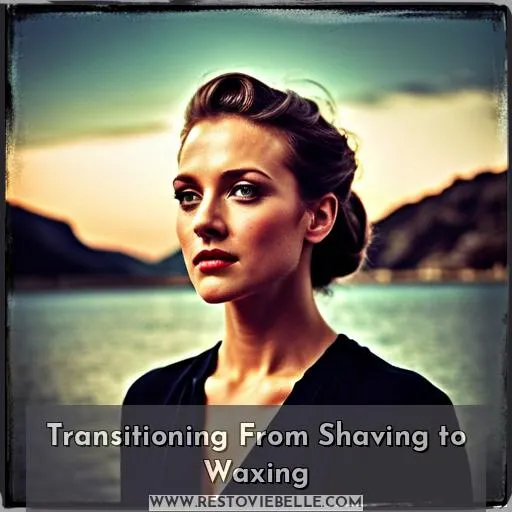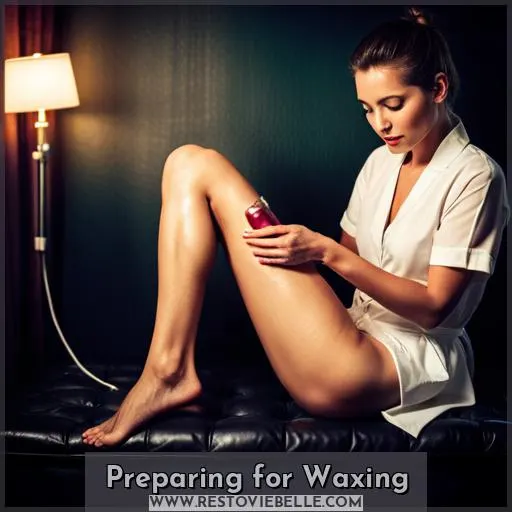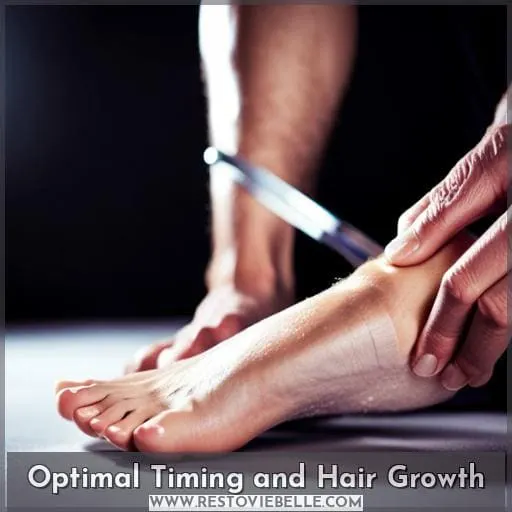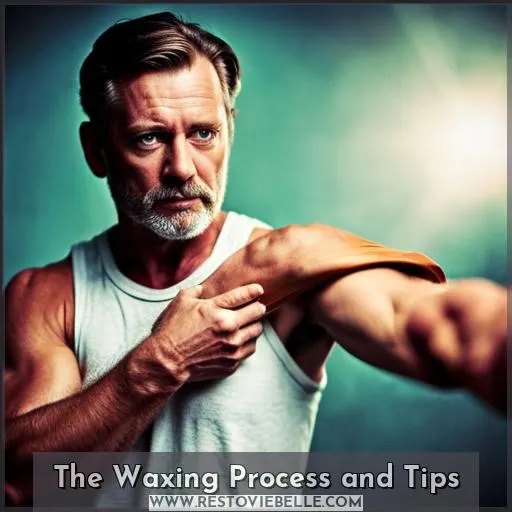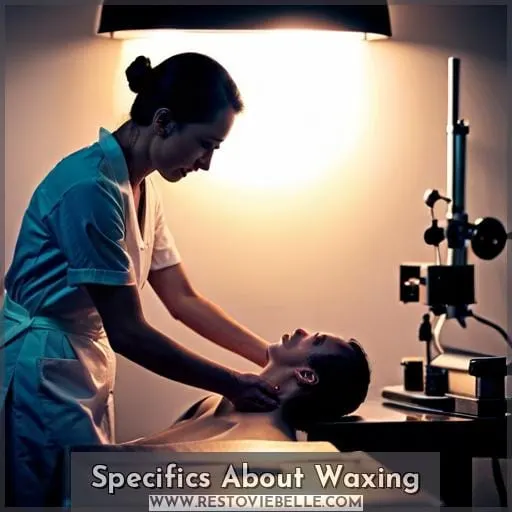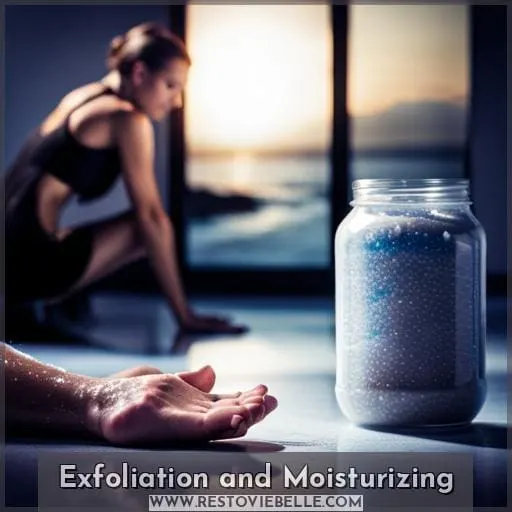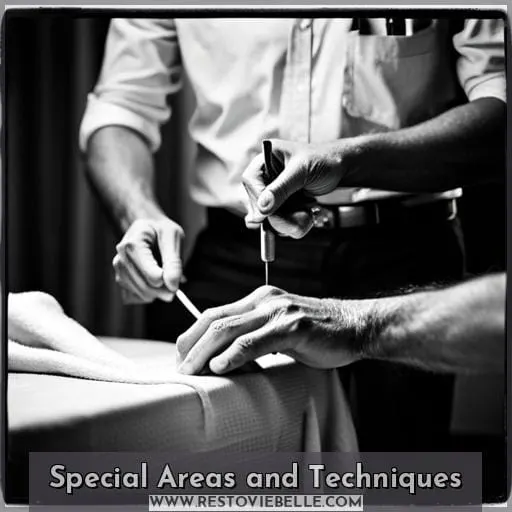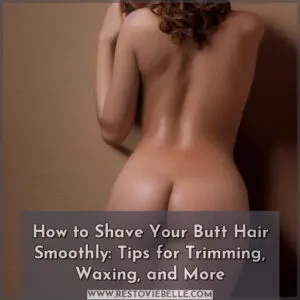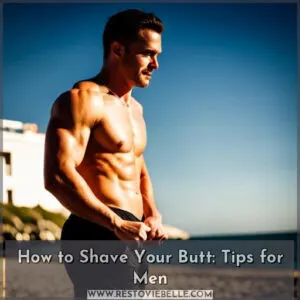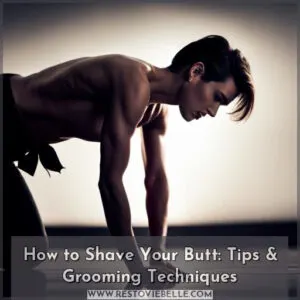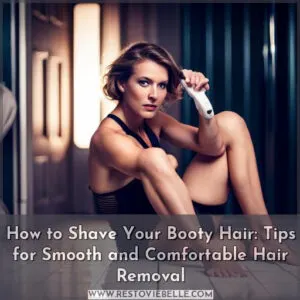This site is supported by our readers. We may earn a commission, at no cost to you, if you purchase through links.
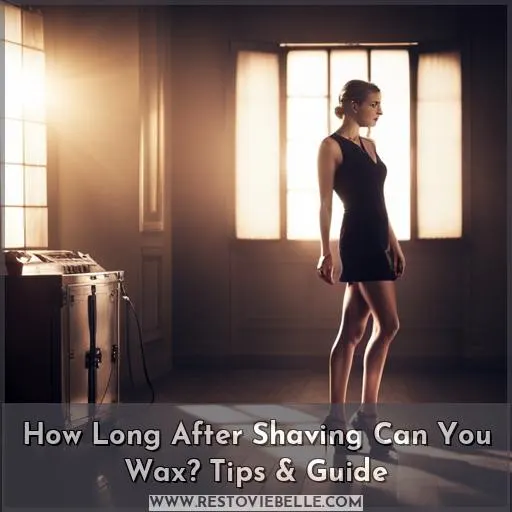 Are you ready to liberate yourself from the tyranny of shaving? If so, waxing is an excellent method for long-lasting hair removal.
Are you ready to liberate yourself from the tyranny of shaving? If so, waxing is an excellent method for long-lasting hair removal.
In this guide, we’ll provide tips on transitioning from shaving to waxing, preparing your skin beforehand, and understanding optimal timing between sessions. We’ll also discuss specific best practices surrounding hot and cold waxes, as well as clothing choices that will aid in keeping irritation at bay.
So read on if you’re ready for a power move towards lasting freedom with smoother skin!
Table Of Contents
Key Takeaways
- Wait 7-10 days post-shave for optimal waxing growth.
- Let hair grow at least half an inch before waxing.
- Exfoliate days prior to waxing, avoiding close to the appointment.
- Maintain waxing interval every 4-6 weeks for long-lasting results.
Transitioning From Shaving to Waxing
To transition from shaving to waxing, prepare your skin with exfoliation and moisturizing. Wait 7-10 days post-shave for optimal growth. Wear comfortable clothing for a more enjoyable experience.
Waxing is an effective way to remove body hair while minimizing waste reduction compared to traditional shaving methods. It’s recommended that you let your hair grow at least half an inch before waxing so the follicle isn’t fully removed by shaving.
Uni K Wax centers offer sustainable options when it comes to wax types, such as stripless or resin-based, which can be faster and less irritating than other types of waxes used in salons.
During each session, conversations are encouraged between the client and professional, providing a non-judgmental atmosphere where liberation, power, and control become achievable through successful results.
Benefits of Waxing
Transitioning from shaving to waxing is an empowering choice for men and women looking for long-lasting results without the constant hassle of upkeep. Waxing offers a smooth, consistent finish that lasts up to three weeks, depending on the type used and how often you choose to go through with it.
Before beginning your transition journey, make sure your hair has at least one-quarter inch or more growth – ten days after shaving is ideal – before starting any type of wax removal process. To maximize effectiveness while minimizing skin irritation, use resin-based strips instead of traditional paper strips as they are gentler on sensitive areas like bikini lines and underarms.
Exfoliating prior will help reduce ingrown hairs, but avoid exfoliating close to the appointment day.
Finally, for optimal comfort during appointments, wear loose clothing that can easily be removed when necessary.
Preparing for Waxing
Prepare for waxing by allowing hair to grow 1/4 inch, exfoliating the skin before and avoiding close to your appointment, getting plenty of sleep and nutrition, as well as moisturizing both pre- and post-wax.
Proper preparation is key for a successful waxing experience; it helps ensure that the transition from shaving is eco-friendly and effective.
Hair Length
For optimal waxing results, your hair should be at least half an inch long – roughly 10-14 days of growth after shaving. However, exfoliation and body sensitivity can impact the required length. Consider using soft wax for sensitive areas and hard or stripless waxes to reduce discomfort during application.
Experiment with different types of wax until you find what works best for you! Keep in mind that exfoliating too close to the appointment time increases skin irritation. Instead, moisturize before and after! With proper preparation, you’ll enjoy a comfortable transition from shaving to sustainable, eco-friendly professional waxing services.
Exfoliation
Don’t let the stubble surprise you – scrub up on exfoliation before waxing to keep those pesky ingrown hairs away.
Exfoliate regularly a few days prior to waxing for best results, and avoid doing so right before or after your appointment.
Moisturize well beforehand too, as it helps create an optimal environment for hair removal while keeping sensitive skin hydrated and taut during the process.
There are different types of waxes available which may determine how often you need to come in – from 10 days with thin hair or 14+ with thicker hair growth stages.
Incorporate these tips into your shaving routine for maximum liberation!
Sleep and Nutrition
Getting a good night’s sleep and eating healthy meals to nourish your body are essential for a successful waxing experience. Sleep hygiene and nutrition advice should be incorporated into any waxing prep routine, as proper rest can reduce sensitivity during the process.
Eating nutrient-rich foods will help hair growth become more consistent while avoiding pre-exfoliation close to appointment day is key.
Pregnant women or children should avoid most types of waxing, but Smooth Wax Bar is a great place to start learning about safe alternatives like Brazilian bikini waxes that won’t irritate sensitive skin!
Preparing for your session correctly ensures you’ll have an enjoyable time with long-lasting results – free from ingrown hairs – ready for it?
Moisturization
Moisturize your skin before and after waxing to keep it hydrated and healthy for optimal results. As part of a cleansing ritual, use body scrubs prior to waxing services for added nourishment.
In addition to moisturizing, ensure hygienic practices are followed such as applying deodorant prior when visiting the uni K Wax center and avoiding touching the bikini area during the session. Pain relief is also possible with long-term care by selecting a preferred wax type while maintaining sanitary conditions between sessions from home or centers that provide safe treatments.
Try incorporating these tips into your routine:
- Cleansing Rituals
- Skin Nourishment
- Deodorant Application
- Long-Term Care
- Hygienic Practices
The implementation of these steps will help ensure a smooth transition from shaving to waxing with lasting effects beyond temporary pain relief – all without compromising on safety!
Optimal Timing and Hair Growth
Wait at least 7-10 days after shaving before waxing for optimal results. This time frame allows hair to reach the required length of 1/4 inch or 3-4 weeks growth, which is essential for successful and comfortable waxing.
If you need a quicker transition from shaving, exfoliation prior to the appointment can help reduce ingrown hairs as long as it’s not done too close to the session itself.
Pain level should be manageable with an experienced esthetician. However, if this is your first time waxing, expect some discomfort that will lessen over subsequent sessions due to better skin care maintenance in between appointments and increased familiarity with techniques used by professional wax only boutiques like Uni K Wax Centers.
They offer sustainable options and are committed to delivering a high level of service while maintaining customer safety through their cancellation policy regarding hair removal services.
The Waxing Process and Tips
At waxing, atmosphere and communication are key. With an engaging, non-judgmental atmosphere during the session, conversations can be had to distract from any pain that may occur – usually just a quick sting.
Follow-up sessions are recommended as waxing regularly will reduce your hair growth rate over time; relaxation techniques can also help improve the overall experience of waxing.
Atmosphere and Communication
Creating a welcoming, friendly atmosphere with meaningful conversations during waxing sessions can make the transition from shaving to waxing an even more pleasant experience. Uni K Wax centers ensure safety and sanitation for all clients while providing tips on skin irritation prevention.
Communication is key when it comes to enhancing the customer experience. Bringing a partner or friend along may be beneficial for first-time clients getting bikini waxes or those undergoing pain during their session.
Tips include acknowledging customers by name, actively listening to concerns and questions, and complimenting them on the bravery and strength they show throughout the appointment process.
All of these components create an inviting space that allows customers to focus on feeling liberated and in control of body care decisions!
Pain Management
Experiencing waxing for the first time can be intimidating, but with proper preparation and relaxation techniques, you can manage any discomfort. Skin irritation is minimized when using the right removal technique, wax type, consistency, and temperature.
When considering an in-betweenie or underarm wax, it’s important to note that some centers offer a child-friendly policy, making this transition easier than ever! Discomfort level varies from person to person, so don’t worry if your experience isn’t exactly like someone else’s – everyone has different thresholds of sensitivity!
Remember: Proper care before and after each session will make all the difference in your journey towards smoothness with minimal skin irritation.
Follow-up Sessions
After waxing, you may need a follow-up session in 4-6 weeks to maintain smoother skin. The type of wax used and your self-care routine determine the optimal frequency for repeat visits. Wax types vary in effectiveness, so talk with the technician about their recommendations.
To avoid ingrown hairs, use proper hygiene when shaving between sessions. Also, ask about any no-show policies if you can’t make it on time for an appointment or event preparation, such as weddings or parties.
With consistent waxing, paired with healthy habits such as exfoliating before and moisturizing after each treatment, your body will thank you!
Relaxation Techniques
Relaxing is key for a successful waxing experience – take time to breathe deep and stay calm during your session. Incorporate mindful breathing, muscle relaxation, aromatherapy, positive affirmations, and guided meditation into the process.
Tanning should be avoided before or after waxing as it can irritate sensitive skin in bikini lines or other areas of the body. Menstruation does not affect results when following proper preparation guidelines.
Environmental benefits come with this transition too! Relaxation techniques ensure an enjoyable experience while maximizing results:
- Mindful Breathing
- Muscle Relaxation
- Aromatherapy
- Positive Affirmations
Enjoy a confident journey towards smoothness without stress every step of the way!
Specifics About Waxing
You may have questions about waxing during menstruation, sensitivity levels, and the duration of results. Waxing every 4-6 weeks is recommended to reduce ingrown hairs, transition, and maintain desired results.
Menstruation Considerations
So, while waxing during your menstrual cycle is accepted, sensitivity should be noted. As a result of hormonal changes that occur during this time, the skin may become extra sensitive. If you’re looking to get bikini lines or underarms waxed, it’s best to wear soft attire and select the right kind of wax for your particular needs, which can vary from person to person.
It’s also important to know how long after shaving one can begin waxing. Waiting 7-10 days post-shave is optimal in order for hair follicles not fully removed by shaving to grow out enough.
Sensitivity
Be prepared for different levels of sensitivity when waxing, which can vary depending on the area. Birth control medication or chemical sensitivities may result in heightened skin reactions. Some areas like bikini lines and underarms may be more sensitive than other parts of the body due to shaving cream and razor use prior to waxing.
Wax strips are often gentler than traditional methods but still require sufficient growth (1/4 inch) before application for best results. Preexisting conditions such as eczema should also be taken into account, as it might affect your skin’s reaction during a wax session.
Duration of Results
The results of waxing can last anywhere from 10 days to 3 weeks, depending on the individual’s hair growth rate.
To ensure long-lasting results, adjust waxing frequency according to one’s skincare needs while considering different types of waxes and shaving habits. If unsure about what is best for you or how often should one get waxed, seek professional advice on proper maintenance practices that work with an individual’s lifestyle.
Incorporate these tips into regular routines to help keep skin smooth without needing frequent touch-ups in between appointments for maximum liberation and control over personal grooming routine.
- Adjust Waxing Frequency According To Skincare Needs
- Consider Different Types Of Waxes & Shaving Habits
- Seek Professional Advice On Proper Maintenance Practices
- Incorporate Tips Into Regular Routines For Maximum Liberation
Recommended Waxing Interval
It’s recommended to wax every 4-6 weeks for best results. To maintain hydration of the skin, use a body lotion before and after waxing. Product choice is important: resin-based waxes are faster and less irritating than traditional types.
Depending on your hair type, you may need follow-up sessions sooner or later to achieve optimal results.
It’s also essential to choose the right pre-waxing products. Exfoliation helps prevent ingrown hairs but should not be done close to the appointment time as it can damage delicate skin cells post-waxing!
Follow these guidelines for successful liberation from unwanted body hair with maximum control over your beauty routine!
Reducing Ingrown Hairs
You can hit two birds with one stone by transitioning to waxing from shaving, reducing the risk of ingrown hairs in the long run.
Follow some simple tips for optimal results:
- Prepare your skin beforehand.
- Engage in conversations during sessions.
Exfoliation and Moisturizing
Exfoliating the skin before waxing is essential for achieving successful results. Timing exfoliation properly, at least several days prior to waxing, helps ensure that hair follicles are not fully removed by shaving and are able to be easily extracted during the waxing process.
Additionally, regularly moisturizing both pre- and post-waxed areas can help keep the skin hydrated and prevent ingrown hairs from forming. Make sure to use a gentle moisturizer after your appointment, as well as ensuring proper hydration with an adequate intake of fluids each day for optimal benefits.
Importance of Exfoliation
Exfoliating regularly is essential when transitioning from shaving to waxing for optimal results. Regular exfoliation helps prevent ingrown hairs caused by residual follicles left after shaving. It also prepares your skin for a smoother wax application and removal, so you can enjoy longer-lasting results with less discomfort.
Wax types and hair growth affect the amount of skin irritation, pain, and hygiene during the waxing process. To maximize comfort levels while minimizing potential issues such as redness or inflammation, make sure to avoid exfoliating close to the appointment day.
Timing of Exfoliation
For best results, the timing of exfoliation prior to waxing is key – like a puzzle piece that completes the picture. Exfoliating 10-14 days before waxing will ensure hair has grown enough for optimal effects.
Waiting 7-10 days post shave also helps. Consistent moisturizing maintains skin and reduces irritations during intervals between waxes. Hair growth rate can be slower with frequent treatments, but too short or infrequent can lead to ingrown hairs and pain from pulling out follicles fully rooted in the skin.
Benefits of Moisturizing
Moisturizing helps keep your skin hydrated and supple, making the waxing process smoother. It’s important to have a moisturizing routine in place prior to, during, and after waxing to prevent dry skin.
Skin health is dependent on many factors, including environment, age, genetics, as well as lifestyle choices that affect hydration levels. Different types of skin may need different products or routines for optimal results.
Ensuring best practices are followed pre-wax day can help you achieve desired outcomes with minimal discomfort.
Hydration Tips
Hydrate your skin before and after waxing for a healthier transition to waxing from shaving. Moisturize daily, even when you’re not waxing, to keep your skin in top condition! After waxing, apply a light moisturizer within the first 24 hours.
Ensure that all products used are specifically designed for post-wax use as they help soothe and protect sensitive areas like bikini lines or underarms.
Clothing and Comfort
When transitioning from shaving to waxing, it is important to consider comfort and clothing. Appropriate attire should be loose-fitting and easily removed for your convenience. Additionally, tight clothes can irritate sensitive skin post-shave, so avoid this where possible; online appointments provide the ideal environment in which you can wear something comfortable of your choice.
Appropriate Attire
Wear loose, comfortable clothing for a waxing session to ensure optimal comfort and reduce irritation of sensitive skin. To achieve this, avoid tight-fitting garments that can rub against freshly waxed areas.
Choose fabrics such as cotton or breathable synthetics for maximum comfort. Consider wearing clothes that are easily removable to minimize disruption during the appointment. Opt for online consultations if you feel more comfortable in your own home attire rather than salon wear.
Research pre-waxing advice, techniques, and products from trusted sources before the big day! Waxing’s safety is paramount; seek professional advice on what’s best suited for you personally based on individual circumstances like hair type and sensitivity level.
Avoiding Irritation
It’s important to choose soft, easily removable clothing when waxing in order to avoid irritating sensitive skin. Studies show that 83% of people who do so experience more successful results. Wax timing should be considered.
Shaving too close before the appointment can cause irritation due to new hair follicles coming up through the skin. Different types of waxes may also result in different levels of discomfort or pleasure, depending on individual preference and preparation done at home prior for best comfort during a session.
Online Appointment Convenience
Making waxing appointments online is a convenient way to ensure you can wear loose, comfortable clothing and feel relaxed during your session. Here are five tips for an optimal experience: 1) Pre-shave with exfoliation 2) Hydrate the skin before and after 3) Choose the appropriate wax selection 4) Consider the duration of results 5) Avoid tight apparel.
Special Areas and Techniques
Ready to take your aesthetic game up a notch? Waxing is the perfect solution for those wanting to smooth out their bikini lines and underarms. Stripless wax offers comfort, while resin-based waxes are faster and less irritating.
Bikini Lines and Underarms
You can wax your bikini lines and underarms easily with the right preparation. Remember to let hair grow to at least half an inch before starting, as well as exfoliate and moisturize ahead of time. Stripless wax is a great option for those looking for comfort during the process, while resin-based waxes are fast and less irritating.
When it comes to intervals between sessions, 10 days up to 3 weeks is recommended – ensure consistent maintenance for best results! But keep in mind that regular waxing reduces the overall growth rate over time, so you won’t need frequent touchups like shaving requires.
With proper care and technique, bikini shaving will be a thing of the past!
Stripless Wax
Stripless wax is a comfortable option for areas such as your bikini line and underarms. Hot waxing techniques are used to remove the hair without the use of a strip, yet still offer precise results with minimal irritation.
Before you begin this process, it’s important to remember some pre-waxing tips: make sure your hair has at least 1/4 inch growth. Exfoliate two days before but avoid on wax day. Hydrate skin beforehand and after removal of any type of wax strip.
Stripless wax can provide effective results when done correctly – so take advantage! With proper preparation and knowledge prior to beginning stripless hot-waxing processes, you’ll be able to achieve great outcomes safely while feeling in control throughout the experience.
Resin-based Waxes
Resin-based waxes are faster and less irritating than the traditional strip wax, so you can enjoy a quicker and more comfortable experience.
- Heat-based waxes reduce pain levels.
- Shaving growth should be half an inch or 10-14 days before pre-waxing.
- Regularly scheduled wax intervals of 4-6 weeks will reduce hair growth rates.
Waxing during menstruation is accepted with sensitivity noted. Results last from 10 days up to 3 weeks depending on individual circumstances. Relax during the process as this increases your overall experience while reducing the ingrown hair cycle due to transitioning away from shaving.
Frequently Asked Questions (FAQs)
How much does waxing typically cost?
Waxing typically costs like a small investment in yourself – one that can bring immense rewards. Enjoy liberation, power, and control through expert waxing services with sustainable options for an eco-friendly transition to smoother skin.
Is waxing painful?
Waxing can be a relatively comfortable process! With proper preparation, waxing is no more painful than a quick sting, and discomfort decreases with consistent sessions.
Can I wax while pregnant?
Yes, you can wax while pregnant! Our experts ensure a safe and comfortable experience with specialized techniques for sensitive areas. Relax and enjoy the transition to sustainable waxing – it’s an empowering journey that delivers long-lasting results.
Are there any contraindications to waxing?
Waxing can be a great way to achieve long-lasting results, but there are certain contraindications. Avoid waxing if you have sunburns or open wounds, and consult with your doctor if you are pregnant or nursing.
Is waxing suitable for sensitive skin?
Yes, waxing is suitable for sensitive skin. With proper preparation and the right techniques, you can enjoy a comfortable experience that is tailored to your needs. Relaxation and conversation will help reduce any discomfort or sensitivity during treatment while providing liberation through control of hair removal.
Conclusion
Transitioning to waxing from shaving can feel like a daunting process, but it’s a step worth taking. Waxing can be a sustainable and eco-friendly option that offers a variety of benefits. Knowing how long after shaving you can wax is key, as well as understanding the preparation necessary for optimal results.
With the right timing and growth, the waxing process can be comfortable and effective. Exfoliation and moisturizing are key elements that can enhance the waxing experience, while loose clothing can help provide comfort as you transition.
With patience, practice, and the right techniques, you can gain the confidence to enjoy longer-lasting, smoother results – all while knowing you made an eco-friendly choice.

